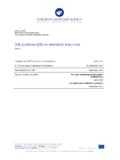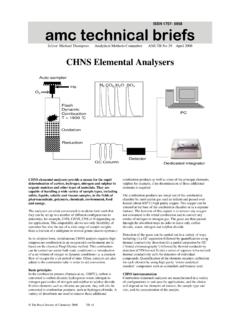Transcription of How to Prepare for the ICH Q3D Elemental …
1 TalkTechThe upcoming implementation of the International Conference on Harmonisation s ICH Q3D Guideline for Elemental Impurities and the United States Pharmacopeia (USP) s General Chapters for Elemental Impurities has triggered its fair share of concern and uncertainty. Some of this is due to the unknown and some is due to a lack of clarity on how these guidelines will be applied to dosage forms and products that don t have a daily dose. The ICH Q3D document is currently at Step 2B, and will be published by the three regulatory regions for public consultation. While we now know the proposed Permitted Daily Exposures (PDEs) to apply, we don t have a complete picture of the levels present in all formulations. In line with ICH, we also have to contend with revisions to USP s General Chapters and their approach to Elemental impurities.
2 So what do companies need to do now to Prepare ? We cannot just wait for the ICH Guideline to reach Step 4 and act then. We must Prepare and act 's ComingElemental impurities in finished drug products can come from several sources, including, but not limited to: Intentionally added (typically catalysts) in synthesis Present as contaminants (interactions with processing equipment) Inherent in components/ingredients (naturally occurring from mined excipients for example)The guideline contains three main aspects: An evaluation of the toxicity data for potential Elemental impurities The establishment of PDEs for each element of toxicological concern Development of controls to limit the inclusion of Elemental impurities in drug products to levels at or below the PDEThe guideline breaks the various Elemental impurities into four different classifications.
3 Class 1: (As, Cd, Hg and Pb): Highly toxic across all administration routes. These require special consideration during the risk assessment, due to their high toxicity and the potential for them to be present in finished dosage form through contributions of naturally derived 2: Toxic to a greater or lesser extent based on route of 3: Relatively low toxicity by oral route of administration, but require consideration in the risk assessment for other routes of 4: Elemental impurities that have been evaluated but for which a PDE has not been established due to their low inherent toxicity and/or regional guideline can be boiled down to four simple steps:1. Identify: Identify the sources of Elemental impurities that are known or suspected, or have the potential to end up in the finished Analyze: Determine the probability of occurrence of the Elemental impurities in the finished dosage Evaluate: Assess the actual or predicted levels of Elemental impurities with the established Control: Develop, document and implement a plan to limit the Elemental impurities in the finished dosage key point that many in the industry have overlooked is the fact that the USP implementation will only apply to finished products with monographs.
4 So that means manufacturers of products like toothpaste and talcum powder can breathe a sigh of relief, while most manufacturers of prescription and over-the-counter medications need to be prepared for the guidelines. But how do you Prepare for the unknown? The How to Prepare for the ICH Q3D Elemental Impurities Guidelineby Janeen Skutnik4 Develop a compliance strategy and proactively share it with your regulators. After you ve developed your compliance strategy, go to the FDA and proactively explain how you are planning to comply with the new guidelines. Include a timeline with key milestones for each product category. Typically, regulators are receptive to these discussions and may be able to provide helpful guidance to modify your plan Engage in discussions with your suppliers.
5 Start having open conversations with your suppliers about the need for data (where available) on the levels of metals present in materials. Consider using tools developed by the International Pharmaceutical Excipients Council of the Americas (IPEC) in order to focus on the right questions. Don t just send out questionnaires and expect your suppliers to return them and comply. Keep in mind, suppliers don t need to comply with the guidelines; manufacturers of finished products need to comply. It s also important to include representatives from your company s quality and compliance organizations in these discussions with suppliers. Don t simply delegate the task to the procurement function View suppliers as partners. It s worth noting that most suppliers of excipients don t really need the additional complexity of dealing with the pharmaceutical industry!
6 Most excipient manufacturers are not manufacturing materials primarily for the pharmaceutical industry. And, typically, the pharmaceutical industry isn't the largest buyer of their materials. For example, only .02 percent of cellulose is used in pharmaceutical products. This presents a special challenge and the need for a bit of diplomacy as we work with suppliers to meet our regulatory requirementsThe bottom line: The pharmaceutical industry has a lot of work to do in the next 10 to 12 months to Prepare for these new Elemental impurities guidelines. There s no time to waste and no sense in burying your head in the sand. Rather than waiting for the FDA or EMA to tell you what to do, manufacturers of finished dosage products must be proactive and start now in a genuine effort to better understand and control Elemental impurities in their guideline will apply initially to all new products as defined within the scope of the consensus draft.
7 So manufacturers need to carefully monitor both USP and ICH activities to determine the impact to their specific product to PreparePharmaceutical companies need to begin preparing now: Determine the impact. Begin to assess your products and what levels of Elemental impurities they contain, remembering that the USP s implementation of Elemental impurities will impact existing drug products from the enforcement date Consider all the potential sources of Elemental impurities: Contributions from Elemental impurities that are intentionally added to reactions or processes leading up to the preparation of the drug substance, reagents, starting materials or excipients ( metal catalysts) Those that are known or suspected to be present in the drug substance, reagents, water, starting materials or excipients used in the preparation of the drug product ( lead present in a mined excipient) Those that are known or suspected of being introduced into the drug substance or drug product from manufacturing equipment Those that are known or suspected of being leached into the drug substance and drug product from container closure systems Engage in discussions with your regulators.
8 Having open conversations with the appropriate regulatory agencies is an important step in compliance with any new guideline Prioritize according to risk. Since most companies are scrambling to address this issue and may not be ready by the time the USP chapter is implemented, I suggest companies prioritize their efforts based on patient/consumer risk. For example, you might want to start with injectable products, then move on to orals and save topical and transdermal products for last. It is advantageous to develop an implementation plan and strategy that documents how your company will address the requirementsJaneen Skutnik is a Vice President at NSF Health Sciences, Pharma Biotech, a division of NSF International. We have more than 30 years of experience in consulting, training and auditing services for the pharmaceutical industry.
9 She can be reached at Health Sciences Pharma Biotech: The Journal Issue 26, Fall 20135

















